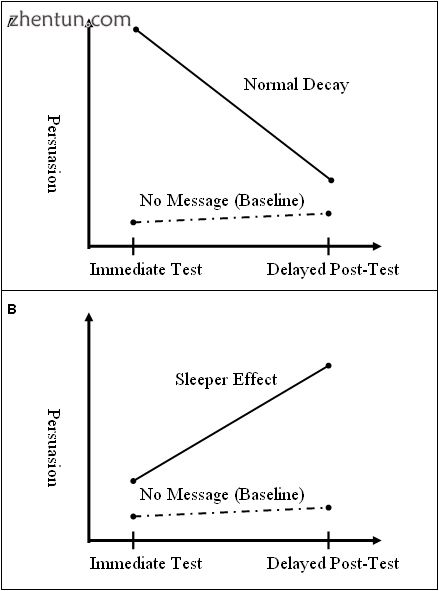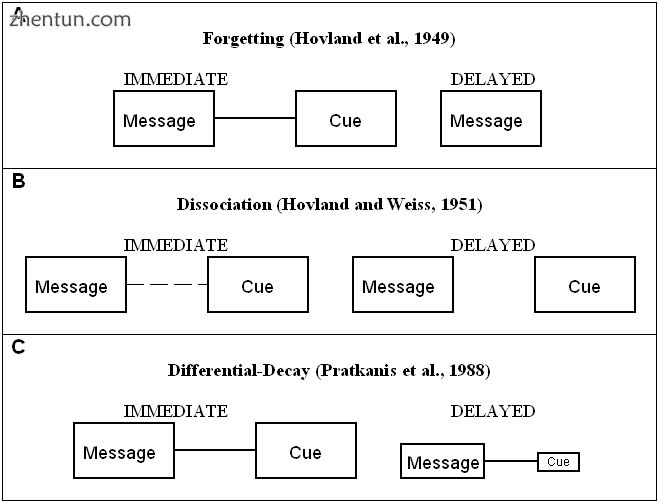睡眠效应是一种与说服有关的心理现象。 这是消息效果的延迟增加,伴随着折扣线索。

图A:正常衰减
图B:睡眠效应
目录
1 睡眠效应
2 关于存在“睡眠效应”的争议
3 首先确定
4 关于睡眠效应如何发生的假设
4.1 忘记和分离
4.2 差分衰减
5 参考
睡眠效应
当人们正常接触到有说服力的信息(例如引人入胜或有说服力的电视广告)时,他们对宣传信息的态度显著增加。
然而,随着时间的推移,他们新形成的态度似乎又倾向于接收信息之前所持的观点,几乎就好像他们从未接触过这种信息一样。 这种态度正常衰退的模式被记录为最常见的说服研究纵向模式(Eagly&Chaiken,1993)。
相反,一些消息通常伴随着折扣提示(例如,消息免责声明,低可信度来源),这将引起接收者怀疑消息的有效性并且抑制可能通过暴露于消息而发生的任何态度改变。单独。此外,当人们接触到有说服力的信息,然后是折扣提示时,人们往往会更加被说服;这被称为睡眠效应(Hovland&Weiss,1951; Cook&Flay,1978)。
例如,在重要选举期间的政治运动中,犹豫不决的选民经常看到关于一方或候选人的负面广告。在广告结束时,他们也可能会注意到对方候选人为广告付费。据推测,这会让选民质疑广告的真实性,因此,最初可能无法说服他们。然而,即使广告的来源缺乏可信度,选民也更有可能在以后被说服(最终,投票反对不受广告影响的候选人)。
近半个世纪以来,这种态度转变模式一直让社会心理学家感到困惑,这主要是由于其反直觉性和它有助于理解态度过程的潜力(Eagly&Chaiken,1993)。这是一个被广泛研究的说服研究现象(Kumkale和Albarracín,2004;另见Cook&Flay,1978)。尽管历史悠久,但除了Gruder等人的一对研究之外,睡眠效应一直很难获得或复制。 (1978年)。
关于存在“睡眠效应”的争议
在早期研究中,睡眠效应给一些研究人员带来的一个更具挑战性的方面是获得这种效应的难度。[1]
睡眠效应是有争议的,因为说服性沟通的影响更大,当衡量更接近演示的效果而不是接收时间更远。[2] [3]
在尝试复制效果并失败后,一些研究人员认为接受零假设并得出睡眠效应不存在可能更好。[4]
睡眠效应与初始信息印象有关,因此这种现象对说服模型有影响,包括教学方法,以及最近的概念化,如启发式 - 系统模型和精化似然模型。[5]
然而,库克和他的同事回应说,以前的研究未能获得睡眠效应,因为没有达到强力测试的要求。具体来说,他们认为只有在下列情况下才会发生睡眠效应:
(a)该讯息具有说服力;
(b)贴现线索具有足够强大的效果来抑制最初的态度变化;
(c)立即和延迟的后测之间已经过了足够的时间;和
(d)在延迟的测试后,信息本身仍然会对态度产生影响。[6]
事实上,进行的实验研究确实提供了在这种理论相关条件下发生的轨枕效应的证据。此外,如果不满足四项要求中的任何一项,就不会发生睡眠效应。[7]
根据分离解释,当令人信服的消息被赋予折扣线索(例如低可信来源或反驳)时,似乎会发生睡眠效应。由于信息的冲动分离和折扣提示随着时间的推移而产生睡眠效应(与简单遗忘信号源相反)。[8]
首先确定
在试图改变他们的观点和道德之后,第二次世界大战期间,美国士兵首先发现了睡眠效应。霍夫兰等人。在他们看到军队宣传的电影介绍后五天或九周测量了士兵的意见。结果发现,观看军队宣传片和未观看电影的人的观点差异在观看后的9周内比5天更大。延迟说服的差异(Hovland等人称之为)睡眠效应,其中实验组的说服力显著增加。[9]
第一次证明这种效果合理的努力与当时对说服过程的理解是一致的。霍夫兰和他的同事介绍了一项研究计划,研究如何回忆信息和消息来源说服睡眠效应。他们首先假设消息接收者随着时间的推移忘记了不可信的通信器,因此最初的消息拒绝减少了。[10]然而,他们后来提出,消息接收者可能并不完全忘记提示,但折扣提示和消息内容的表示之间的关联可能随着时间的推移而消失并产生睡眠效应。[11]这两种表述的不同之处在于(a)遗忘表明提示的痕迹随着时间的推移在记忆中消失或变得不可用,而(b)分离表明提示在记忆中仍然可用,但在关系中更容易检索(不太容易获得)谈到交流的主题。[12]
关于睡眠效应如何发生的假设
由于睡眠效应被认为是违反直觉的,研究人员自20世纪50年代初就试图解释它是如何以及为何发生的。

图A:遗忘
图B:解离
图C:差分衰减
遗忘和分离
根据遗忘假设,与消息相关联的折扣提示最初减少了对消息的接受。随着时间的推移,如果接受者忘记提示,可以观察到说服力的延迟增加,但回想起消息的优点(Hovland等,1949)。为了验证这一假设,Hovland和他的同事(Hovland&Weiss,1951; Kelman&Hovland,1953; Weiss,1953)发起了一系列实验,参与者收到的信息归因于值得信赖或不值得信赖的来源,然后完成了意见测量。以及回忆消息内容和来源。总体而言,具有可靠来源的信息比不可靠来源提供的信息产生了更大的初始说服力。
Hovland,Lumsdaine和Sheffield(1949)首次通过一项著名的研究发现了这种效应,该研究证明了第二次世界大战宣传片对美国士兵的影响延迟。
由于一部分条件导致参与者对电影中信息源的可信度提出质疑,参与者后来报告说他们的说服力略有增加(这让研究人员大吃一惊)。在检查结果后,他们最初假设忘记折扣提示(在这种情况下,不可信的来源)导致了这种效果。然而,随着时间的推移,可靠来源提供的信息的影响已经衰退,而不可靠来源提供的信息的影响要么保持不变,要么略有增加。尽管有证据表明这一系列研究的睡眠效应,但召回措施表明接受者在延迟随访时仍记得不可信的消息来源。
这是忘记假设被解离假设所取代的时候。现在根据分离假设,睡眠效应不需要暗示折扣线索在记忆中永久不可用。提示和消息之间的弱化关联可能足以使睡眠效果发生。随着关联随着时间的推移而减弱,使得提示与通信主题相关的可访问性降低,只要消息参数仍然令人难忘,说服的说服可能会延迟增加。在这种程度上,有助于保留消息内容的因素应该创建有利于睡眠效果的设置。
根据这种推理,发生睡眠效应是因为折扣线索与记忆中的信息之间的关联随着时间的推移而变弱;因此,当为了产生态度而召回消息时,源不容易关联。
差分衰减
Hovland和他的团队忽略了这一点很重要的是,为什么随着时间的推移,折扣提示变得比消息更难以获得,即使两个片段在开始时同样有效。为了回答这个问题,Greenwald,Pratkanis和他们的团队(Greenwald等,1986; Pratkanis等,1988)实施了一项研究,以确定睡眠效应发生和不发生的条件。 Pratkanis执导了一系列17次实验,其中他在消息之前或之后提出了折扣提示,并发现睡眠效应主要发生在提示跟随消息时,而不是当提示是第一次时。为了解释他的发现,Pratkanis和他的团队提出了一个改进的遗忘假设,这表明睡眠效应的产生是因为信息和线索的效果以不同的速率衰减。基于该建议,消息和提示表现为两个以相反方向操作的通信。当这些通信的效果大致相等,并且在消息暴露之后立即产生睡眠效应,但是后来提示的效果比消息的效果更快地衰减。然而,折扣线索的时间对于产生效果至关重要,因为首先呈现的信息持续时间更长,而更近期的信息消失得更快(Miller&Campbell,1959)。因此,当在说服性通信结束时发生折扣提示并且刺激消息内容的首要效应时,应该发生睡眠效应。多年后,Pratkanis,Greenwald,Leippe和Baumgardner(1988)提出了另一种与Hovland及其同事不同的假设。
他们认为,解离假设并没有强调睡眠效应更可能发生的条件。此外,Gruder等人规定了对睡眠效应的要求。 (1978)没有详细说明观察睡眠效应所需的经验条件。
另见:
Mind and Brain portal
Psychology portal
Disinformation
Framing (social sciences)
Misinformation
Propaganda
Psychological manipulation
注解:
Capon, N; J. Hulbert (1973). "The Sleeper Effect - An awakening". Public Opinion Quarterly. 37: 333. doi:10.1086/268097.
Cook, TD; BR FLay (1978). "The persistence of experimentally induced attitude change".
Eagly, Ah; S. Chaiken (1993). "The psychology of attitudes".
Gillig, PM; AG Greenwald (1974). "Is it time to lay the sleeper effect to rest?". Journal of Personality and Social Psychology. doi:10.1037/h0035744.
Kumkale, G. Tarcan; Dolores Albarracín (23 May 2011). "The Sleeper Effect in Persuasion: A Meta-Analytic Review". doi:10.1037/0033-2909.130.1.143.
Cook, TD; CL Gruder; KM Hennigan; BR Flay (1979). "History of the Sleeper Effect: Some Logical Pitfalls in Accepting the Null Hypothesis". Psychological Bulletin. 86: 662–679. doi:10.1037/0033-2909.86.4.662.
Gruder, CL; TD Cook; KM Hennigan; BR Flay; C Alessis; J Halamaj (1978). "Empirical tests of the absolute sleeper effect predicted from the discounting-cue hypothesis". Journal of Personality and Social Psychology. doi:10.1037/0022-3514.36.10.1061.
Pratkanis, Anthony R.; Leippe; Greenwald; Baumgardner (1988). "In Search of Reliable Persuasion Effects: The Sleeper Effect is Dead. Long Live the Sleeper Effect". Journal of Personality and Social Psychology. 54. doi:10.1037/0022-3514.54.2.203.
Kumkale, G. Tarcan; Dolores Albarracín (23 May 2011). "The Sleeper Effect in Persuasion: A Meta-Analytic Review".
Hovland, CL; W Weiss (1951). "The Influence of Source Credibility on Communication Effectiveness". Public Opinion Quarterly. 15: 635. doi:10.1086/266350.
Hovland, CL; W Weiss (1951). "The Influence of Source Credibility on Communication Effectiveness". Public Opinion Quarterly. 15: 635. doi:10.1086/266350.
Kumkale, G. Tarcan; Dolores Albarracin (2004). "The Sleeper Effect in Persuasion: A Meta-Analytic Review".
参考:
Capon, N.; Hulbert, J. (1973). "The Sleeper Effect — An Awakening". Public Opinion Quarterly. 37 (3): 333–358. doi:10.1086/268097.
Cook, T. D.; Flay, B. R. (1978). "The Persistence of Experimentally-Induced Attitude Change". Advances in Experimental Social Psychology. 11: 1–57. doi:10.1016/s0065-2601(08)60004-0.
Cook, T. D.; Gruder, C. L.; Hennigan, K. M.; Flay, B. R. (1979). "History of the Sleeper Effect: Some Logical Pitfalls in Accepting the Null Hypothesis". Psychological Bulletin. 86 (4): 662–679. doi:10.1037/0033-2909.86.4.662.
Eagly, A.K., & Chaiken, S., The Psychology of Attitudes, Harcourt Brace Jovanovich, (Fort Worth), 1993.
Gillig, P.M.; Greenwald, A.G. (1974). "Is it Time to Lay the Sleeper Effect to Rest?". Journal of Personality and Social Psychology. 29 (1): 132–139. doi:10.1037/h0035744.
Gruder, C.L.; Cook, T.D.; Hennigan, K.M.; Flay, B.R.; Alessis, C.; Halamaj, J. (1978). "Empirical Tests of the Absolute Sleeper Effect Predicted from the Discounting Cue Hypothesis". Journal of Personality and Social Psychology. 36 (10): 1061–1074. doi:10.1037/0022-3514.36.10.1061.
Hovland, C.I., Lumsdale, A.A. & Sheffield, F.D, Experiments on Mass Communication: Studies in Social Psychology in World War II: Volume III, Princeton University Press, (Princeton), 1949.
Hovland, C.I.; Weiss, W. (1951). "The Influence of Source Credibility on Communication Effectiveness". Public Opinion Quarterly. 15 (4): 635–650. doi:10.1086/266350.
Kumkale, G.T.; Albarracín, D. (2004). "The Sleeper Effect in Persuasion: A Meta-Analytic Review". Psychological Bulletin. 130 (1): 143–172. doi:10.1037/0033-2909.130.1.143.
Pratkanis, A.R.; Greenwald, A.G.; Leippe, M.R.; Baumgardner, M.H. (1988). "In Search of Reliable Persuasion Effects: III. The Sleeper Effect is Dead. Long Live the Sleeper Effect". Journal of Personality and Social Psychology. 54 (2): 203–218. doi:10.1037/0022-3514.54.2.203.
Greenwald, AG; Pratkanis, AR; Leippe, MR; Baumgardner, MH (1986). "Under what conditions does theory obstruct research progress?". Psychological Review. 93: 216–229. doi:10.1037/0033-295x.93.2.216.
Lariscy, RAW; Tinkham, SF (1999). "The sleeper effect and negative political advertising". Journal of Advertising. 4: 13–30. doi:10.1080/00913367.1999.10673593.
Petty RE, Wegener DT. The elaboration-likelihood model: Current status and controversies. In: Chaiken S, Trope Y, editors. Dual process theories in social psychology. Guilford Press; New York: 1999. pp. 41–72.
Petty, RE; Wegener, DT; Fabrigar, LR; Priester, JR; Cacioppo, JT (1993). "Conceptual and methodological issues in the elaboration-likelihood model of persuasion: A reply to the Michigan State critics". Communication Theory. 3: 336–363. doi:10.1111/j.1468-2885.1993.tb00078.x.
进一步阅读:
Ajzen, I., "Persuasive Communication Theory in Social Psychology: A Historical Perspective", pp. 1–27 in Manfredo, M.J. (ed.), Influencing Human Behavior: Theory and Applications in Recreation, Tourism, and Natural Resources Management, Sagamore Publishing, (Champaign), 1992. [1]
Catton, W.R. (1960). ""Changing Cognitive Structure as a Basis for the "Sleeper Effect". Social Forces. 38 (4): 348–354. doi:10.2307/2573045.
Cohen, A.R., "Need for Cognition and Order of Communication as Determinants of Opinion Change", pp. 79–97 in Hovland, C.I. (ed.), The Order of Presentation in Persuasion, Yale University Press, (New Haven), 1957.
Hannah, D.B.; Sternthal, B. (1984). "Detecting and Explaining the Sleeper Effect". The Journal of Consumer Research. 11 (2): 632–642. doi:10.1086/209000.
Hovland, C.I., "Introduction", pp. 1–10 in Hovland, C.I. (ed.), The Order of Presentation in Persuasion, Yale University Press, (New Haven), 1957.
Hovland, C (1959). "Reconciling Conflicting Results Derived From Experimental and Survey Studies of Attitude Change". American Psychologist. 14 (1): 8–17. doi:10.1037/h0042210.
Hovland, C.I., Janis, I.L. & Kelley, H.H., Communication and Persuasion: Psychological Studies of Opinion Change, Yale University Press, (New Haven), 1953.
Lariscy, R.A.W.; Tinkham, S.F. (1999). "The Sleeper Effect and Negative Political Advertising". Journal of Advertising. 28 (4): 13–30. doi:10.1080/00913367.1999.10673593.
Mazursky, D.; Schul, Y. (2000). "In the Aftermath of Invalidation: Shaping Judgment Rules on Learning that Previous Information was Invalid". Journal of Consumer Psychology. 9 (4): 213–222. doi:10.1207/s15327663jcp0904_3.
Mazursky, D.; Schul, Y. (1988). "The Effects of Advertisement Encoding on the Failure to Discount Information: Implications for the Sleeper Effect". Journal of Consumer Research. 15 (1): 24–36. doi:10.1086/209142.
McGuire, W.J. (1997). "Creative Hypothesis Generating in Psychology: Some Useful Heuristics". Annual Review of Psychology. 48 (1): 1–30. doi:10.1146/annurev.psych.48.1.1.
Priester, J.; Wegener, D.; Petty, R.; Fabrigar, L. (1999). "Examining the Psychological Process Underlying the Sleeper Effect: The Elaboration Likelihood Model Explanation". Media Psychology. 1 (1): 27–48. doi:10.1207/s1532785xmep0101_3.
Schulman, G.I.; Worrall, C. (1970). "Salience Patterns, Source Credibility, and the Sleeper Effect". Public Opinion Quarterly. 34 (3): 371–382. doi:10.1086/267813.
Sitton, S.C.; Griffin, S. (1980). "The Sleeper Effect in Reconstructive Memory". Journal of General Psychology. 103 (1): 21–25. doi:10.1080/00221309.1980.9711753.
Underwood, J.; Pezdek, K. (1998). "Memory Suggestibility as an Example of the Sleeper Effect". Psychonomic Bulletin and Review. 5 (3): 449–453. doi:10.3758/bf03208820.
Weiss, W (1953). "A "Sleeper" Effect in Opinion Change". Journal of Abnormal and Social Psychology. 48 (2): 173–180. doi:10.1037/h0063200.
Wilson, T.D.; Lindsey, S.; Schooler, T.Y. (2000). "A Model of Dual Attitudes". Psychological Review. 107 (1): 101–126. doi:10.1037/0033-295x.107.1.101. |